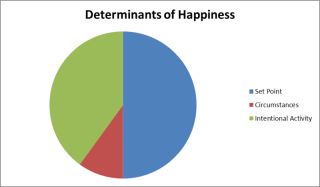Positive Psychology
Transform Your Life With 10 Tips From Happiness Courses
These fun, brief activities will improve your mood and well-being.
Updated January 27, 2024 Reviewed by Ray Parker
Key points
- Happiness classes help students use findings from positive psychology research in daily life.
- Happiness is achievable through evidence-based techniques and doesn't require formal courses.
- Happiness interventions can pay off in terms of immediate mood lift and sustained well-being.

When you were in college, did you take a "happiness course?" Such classes are usually taught by psychology or counseling professors and are now relatively common, but they did not exist when I was an undergraduate. If they had, I think my college and post-college years would have been significantly better.
I say that because, over the years, I've collected happiness tips from positive psychology experts who study the science of well-being. I use these tips on a daily basis to infuse my life with more joy and meaning. They work. So I'm passing you what I wish I'd known then.
It's Never Too Late to Take a Happiness Course
Happiness courses are called by various names, such as The Psychology of Happiness, Positive Psychology, and The Science of Well-Being. The origin of such courses can be traced back to psychologist Martin Seligman, who advocated in the 1990s that psychology focus more on mental wellness rather than just on mental illness. His books, and those of others, changed the field. One result: Various happiness interventions are now taught in formal classes, passed on by therapists and counselors, and are written about extensively in the self-help literature.
This post will offer you various tips and techniques from happiness courses and positive psychology research. There is no need to register, buy a textbook, or worry about a grade. Just read and choose one to three tips to try. You may want to create a journal about your experiences. Experiment with what works for you, and soon, you'll have created your own happiness curriculum and even your own definition of happiness.
Free and Easy Happiness Tips
Happiness stems from a variety of sources, including pleasure, meaning, self-appreciation, and relationships. These tips will give you a dose of each.
1. Smile. Simple and powerful. Try it now, even if you don't feel like it, because even a half-hearted smile will release "feel-good chemicals" like serotonin and dopamine in your brain, as I write here. Professor and counselor Rhonda O'Cana, who teaches a Happiness Matters course, recommends that you start off each day with a smile.
Smile frequently during the day, whether at people you pass on the street or alone in your car. Do you experience a mood lift? (Note: These smiles are deliberate and self-chosen, unlike the fake ones you sometimes must force yourself to make in certain work or dating situations.)
2. Do the iconic "three good things" exercise. The basics: Toward the end of each day, take notes in a gratitude journal (mental notes can work, too.) about 3-5 good things that happened during the day. Ask yourself why these things happened. Was it luck? Someone's kindness? Your kindness? Your hard work? Your attitude? It's important to note that "The Three Good Things" can be tiny—savoring a good cup of coffee, for example—or huge, like finishing a big project. Learn to spot the success, and you'll increase your self-confidence along with your happiness.
3. Schedule at least one pleasurable activity each day. Schedule at least one enjoyable activity each day, no matter how small, and ensure you do it. Do a crossword at lunch, talk with a friend, take a break, watch your favorite TV show, or watch the birds. Whatever works for you.
4. Chat with friends, acquaintances, and strangers. Life satisfaction rises even when you have "minimal social interactions," as described in this study. Just greeting someone or saying "thank you" can lead to greater life satisfaction. Talk about giving a little and getting a lot.
5. Listen to someone you care about for one to five minutes. Connecting with significant others is a major source of happiness across the lifespan. Listening to others is a potent source of relationship satisfaction. To quote Zen teacher John Tarrant: "Attention is the most basic form of love."
6. Take a walk in nature. No doubt you already have read that both walking and being in nature reduce stress and lift your mood. Do both together and get a twofer.
7. Perform an act of kindness, random or planned. Write a note to someone, help a busy parent by taking their grocery cart back, or call someone who might be lonely.
8. Count your blessings. When you are having a bad day, counting your blessings can provide much-needed perspective. Reciting these mottoes can help me reframe my own troubles: "My worst day is someone else's best day." "Things can always be worse." Noticing your blessings on a good day works to increase well-being, too. The power of gratitude is a well-researched phenomenon. (One example here.)
9. Forgive yourself when you make mistakes or do a less-than-stellar job at something. Remind yourself that mistakes are part of the process of learning and living. Have the courage to be imperfect, and you'll find you become more productive with less stress.
10. Express your creativity. Journal, take photos, make something, solve problems. If you don't have much time, keep it small. For example, just write in your journal for one minute.
Summing Up

Sonja Lyubomirsky, Ph.D., author of The How of Happiness and other books, popularized the idea that happiness was not just a product of genetics and environment; about 40 percent was within your conscious control. Happiness interventions allow you to improve your own well-being deliberately.
Besides the advantage of maximizing happiness, these interventions have other not-so-obvious benefits. For example, knowing how to generate positive feelings seems to relieve the suffering of many with mental health diagnoses, help people see their strengths, and help them cope with challenging or difficult times. And since happiness and health are linked, practicing the simple happiness activities above will improve your health as well as your emotional well-being.
What will you learn in the pursuit of your own happiness? Try these interventions and find out.
References
Rhonda O'Cana, happiness courses. Rhodes, Lisa R. “Happy Days.” Counseling Today, Jan. 2024, p. 37 ff.
Oswaks, M. "Over 3 Million People Took This Course on Happiness. Here's What Some Learned." New York Times, March 13, 2021.
Lyubomirsky, S. (2008). The How of Happiness: A Scientific Approach to Getting the Life You Want. NY: Penguin Press.




